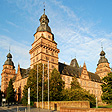JOHANNISBURG
PALACE & PARK
Renaissance Residence Palace of Aschaffenburg
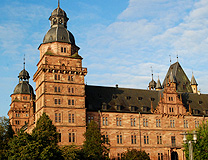 It
is a truly impressive sight entering the city of Aschaffenburg. The Johannisburg
Palace sits on a bluff above the River Main, dominating
the center of the city. Built in 1605 through 1614, the palace served
as a second residence for the Electoral Archbishops of Mainz until
1804. It is a massive square walled complex around an inner courtyard
with four towers on the corners capped by domed roofs, with a fifth
tower forming the entrance gate. The palace was designed by an architect
from Strasbourg, Georg Ridinger, to replace an earlier medieval fortress
castle which stood on the spot, and is one of the most important
examples of German royal palace architecture from the Renaissance
era, with the additional feature of the tower keep left standing
from the former 14th century castle incorporated into the design.
It
is a truly impressive sight entering the city of Aschaffenburg. The Johannisburg
Palace sits on a bluff above the River Main, dominating
the center of the city. Built in 1605 through 1614, the palace served
as a second residence for the Electoral Archbishops of Mainz until
1804. It is a massive square walled complex around an inner courtyard
with four towers on the corners capped by domed roofs, with a fifth
tower forming the entrance gate. The palace was designed by an architect
from Strasbourg, Georg Ridinger, to replace an earlier medieval fortress
castle which stood on the spot, and is one of the most important
examples of German royal palace architecture from the Renaissance
era, with the additional feature of the tower keep left standing
from the former 14th century castle incorporated into the design.
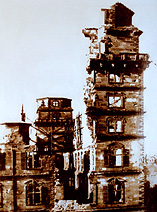 The
Johannisburg Palace was heavily damaged by bombing in World War
II, with Aschaffenburg located in the industrial region surrounding
Frankfurt and the Main-Rhine zone. The palace was meticulously
reconstructed
starting with the exterior of striking red sandstone. The interior
state rooms and collections were re-opened in the 1960s, featuring
the palace church with its Renaissance altar and portal sculptures
by Hans Juncker, the original neo-classical rooms and furniture of
the apartments of the Mainz Princes, and the Vestment Chamber with
the vestments from the former Mainz Cathedral Treasury (see Mainz
Cathedral). A tour of the Palace Museum includes the
State Art Gallery with Old German and Dutch art, highlighted by painting
by Lucas Cranach
the Elder and his acolytes, medieval sculptures, ceramics, furniture
and painting by Christian Schad. Perhaps the most unique display
in the Johannisburg Palace is the collection of architectural models
made of cork. These amazingly detailed miniature reproductions of
the most famous ruins of ancient Rome, were made by the archbishops
court confectioner Carl May and his Son, who turned their skills
from cake to cork beginning in 1792.
The
Johannisburg Palace was heavily damaged by bombing in World War
II, with Aschaffenburg located in the industrial region surrounding
Frankfurt and the Main-Rhine zone. The palace was meticulously
reconstructed
starting with the exterior of striking red sandstone. The interior
state rooms and collections were re-opened in the 1960s, featuring
the palace church with its Renaissance altar and portal sculptures
by Hans Juncker, the original neo-classical rooms and furniture of
the apartments of the Mainz Princes, and the Vestment Chamber with
the vestments from the former Mainz Cathedral Treasury (see Mainz
Cathedral). A tour of the Palace Museum includes the
State Art Gallery with Old German and Dutch art, highlighted by painting
by Lucas Cranach
the Elder and his acolytes, medieval sculptures, ceramics, furniture
and painting by Christian Schad. Perhaps the most unique display
in the Johannisburg Palace is the collection of architectural models
made of cork. These amazingly detailed miniature reproductions of
the most famous ruins of ancient Rome, were made by the archbishops
court confectioner Carl May and his Son, who turned their skills
from cake to cork beginning in 1792.
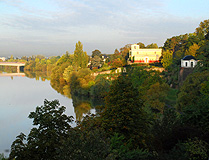 A
visit to the Johannisburg Palace is complimented by a stroll through
the gardens along the steep shore of the Main River to the Roman
recreated villa of the Pompeiianum. Take in a panoramic view of the
river along the balustrade of the terrace, along a section of the
original medieval town wall to the 18th Century folly of the Breakfast
Temple, designed in 1782 by von Herigoyen as a spot for the royal
electors to take in their beautiful domain. Continue across the forest
footbridge and the 1780's landscape garden of Friedrich Ludwig Sckell
to the Pompeiianum.
A
visit to the Johannisburg Palace is complimented by a stroll through
the gardens along the steep shore of the Main River to the Roman
recreated villa of the Pompeiianum. Take in a panoramic view of the
river along the balustrade of the terrace, along a section of the
original medieval town wall to the 18th Century folly of the Breakfast
Temple, designed in 1782 by von Herigoyen as a spot for the royal
electors to take in their beautiful domain. Continue across the forest
footbridge and the 1780's landscape garden of Friedrich Ludwig Sckell
to the Pompeiianum.
Pompeiianum
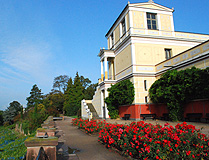 This
palace addition, the Pompeiianum (Pompejanum) was never intended
as a residence but more public art exhibit inspired by the excavations
of the
volcano
destroyed
Roman city of Pompeii was commissioned by King Ludwig I of Bavaria
and built from 1840 to 1848, designed by architect Friedrich von
Gärtner. Not an exact replica of any particular building, the
Pompeiianum of Aschaffenburg is an idealized version of a Roman Villa.
The German kings traced their lineage to the Holy Roman Emperors
held a fascination with the ancient life and history so added these
features to their palaces (see Residence Palace Munich). The Pompeiianum
displays original works of Roman art and from the State collections
of Bavaria. Among the most valuable exhibits aside from the marble
sculptures and bronzes are two marble thrones of the gods.
This
palace addition, the Pompeiianum (Pompejanum) was never intended
as a residence but more public art exhibit inspired by the excavations
of the
volcano
destroyed
Roman city of Pompeii was commissioned by King Ludwig I of Bavaria
and built from 1840 to 1848, designed by architect Friedrich von
Gärtner. Not an exact replica of any particular building, the
Pompeiianum of Aschaffenburg is an idealized version of a Roman Villa.
The German kings traced their lineage to the Holy Roman Emperors
held a fascination with the ancient life and history so added these
features to their palaces (see Residence Palace Munich). The Pompeiianum
displays original works of Roman art and from the State collections
of Bavaria. Among the most valuable exhibits aside from the marble
sculptures and bronzes are two marble thrones of the gods.
Visiting the Johannisburg Palace & Court Gardens
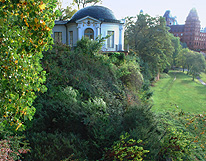 The
Johannisburg Palace is open Tuesdays through Sundays - 9 am to
6 pm April through September and 10 am to 6 pm October to March,
closed on Mondays. The Pompeiianum is closed from Mid-October through
March and closed. Admission for the palace is 5.50€ regular,
4.50€ reduction, seniors and students, and a combined ticket
for the palace and Pompeiianum is 9€ regular and 7€ reduction.
The
Johannisburg Palace is open Tuesdays through Sundays - 9 am to
6 pm April through September and 10 am to 6 pm October to March,
closed on Mondays. The Pompeiianum is closed from Mid-October through
March and closed. Admission for the palace is 5.50€ regular,
4.50€ reduction, seniors and students, and a combined ticket
for the palace and Pompeiianum is 9€ regular and 7€ reduction.
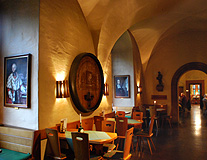 The
Johannisburg Palace also houses the city library and for refreshments,
the Schloss Weinstube is open for lunch and dinner, located in
the lower wing of the building. The palace is steps from the city
center
and there is parking. Aschaffenburg is in the Franconia region
of northern Bavaria, more connected to Rhine-Main region than southern
Bavaria. The palace is administered by the Bavarian State Palaces
Department, while the Schloss Museum is administered by the Aschaffenburg
museum department. The third Bavarian palace property in Aschaffenburg
is the Schönbusch Palace and Park in a former royal deer park
a five minute drive from the city center toward Darmstadt (see Schonbusch Park Palace). © Bargain
Travel Europe
The
Johannisburg Palace also houses the city library and for refreshments,
the Schloss Weinstube is open for lunch and dinner, located in
the lower wing of the building. The palace is steps from the city
center
and there is parking. Aschaffenburg is in the Franconia region
of northern Bavaria, more connected to Rhine-Main region than southern
Bavaria. The palace is administered by the Bavarian State Palaces
Department, while the Schloss Museum is administered by the Aschaffenburg
museum department. The third Bavarian palace property in Aschaffenburg
is the Schönbusch Palace and Park in a former royal deer park
a five minute drive from the city center toward Darmstadt (see Schonbusch Park Palace). © Bargain
Travel Europe
Hotel
and vacation deals in Franconia
Bavaria on TripAdvisor
German
High Speed Train ICE
Booking Center
Web
Info
Bavaria
Palaces
Aschaffenburg
Museums
These articles are copyrighted and the sole property of Bargain Travel Europe and WLPV, LLC. and may not be copied or reprinted without permission.
See Also:
ST PETER AND ALEXANDER TREASURY
SCHLOSS NYMPHENBURG PALACE AND GARDENS
SCHLOSS EGGERSBERG CASTLE HOTEL ALTMUHLTAL
HOTEL JAGDSCHLOSS KRANICHSTEIN
CHRISTMAS MARKETS – FRANKFURT RHINE-MAIN

